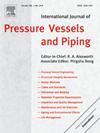Structure-property relationships in electron beam welded SA508 nuclear reactor pressure vessel steel
IF 3.5
2区 工程技术
Q2 ENGINEERING, MECHANICAL
International Journal of Pressure Vessels and Piping
Pub Date : 2025-07-11
DOI:10.1016/j.ijpvp.2025.105605
引用次数: 0
Abstract
The objective of this study is to understand structure-property relationships across electron beam (EB) welds on nuclear reactor pressure vessel (RPV) steel SA508, Grade 3. Modern nuclear reactor designs typically rely on single-forging RPVs in an effort to eliminate arc welds that require costly in-service inspection. By comparison, advanced EB welds are being considered for RPV applications as they can be rapidly produced, quality heat treated, and often exhibit fewer impurities and narrower heat-affected zones (HAZ). But little is known about microstructure evolution during EB welding and its implications on mechanical properties. This work identifies key structure-property relationships in electron beam welds on forged SA-508 and on a powder metallurgy with hot isostatic pressing (PM-HIP) compact produced to match the SA508 Grade 3 chemical composition. In both the forging and PM-HIP compact, the EB weld fusion zone and HAZ exhibit significant hardening due to martensite nucleation during rapid cooling, while the base metal retains a dual-phase ferrite-bainite microstructure. An appropriately designed heat treatment can eliminate hardness gradients by homogeneously recrystallizing a ferrite-bainite microstructure across the weldment. While PM-HIP and forged SA508 exhibit similar EB weld-induced microstructure evolution, the more extensive porosity in the PM-HIP specimen promotes grain growth and stabilizes ferrite and martensite. Hardness is governed by ferrite phase contiguity, wherein dislocation transmission is inhibited at dissimilar phase interfaces. But if the microstructure is dominated by bainite and/or martensite, hardness is instead governed by their phase fractions. This work illustrates the potential for combining EB welding and PM-HIP with an appropriate quality heat treatment to create RPV welds having negligible microstructure gradients and consistent hardening micro-mechanisms.

电子束焊接SA508核反应堆压力容器钢的组织-性能关系
本研究的目的是了解核反应堆压力容器(RPV)钢SA508 3级电子束(EB)焊缝之间的结构-性能关系。现代核反应堆的设计通常依赖于单锻rpm,以消除电弧焊接,而电弧焊接需要昂贵的在役检查。相比之下,先进的EB焊接被考虑用于RPV应用,因为它们可以快速生产,高质量的热处理,并且通常具有更少的杂质和更窄的热影响区(HAZ)。但是对于电子束焊接过程中组织的演变及其对力学性能的影响却知之甚少。这项工作确定了锻造SA-508和粉末冶金热等静压(PM-HIP)致密体上电子束焊接的关键结构-性能关系,以匹配SA508 3级化学成分。在锻件和PM-HIP压缩件中,由于快速冷却过程中马氏体成核,EB焊缝熔合区和热影响区表现出明显的硬化,而母材保持双相铁素体-贝氏体组织。适当设计的热处理可以通过在焊件上均匀地再结晶铁素体-贝氏体组织来消除硬度梯度。虽然PM-HIP和锻态SA508表现出相似的EB焊接诱导的组织演变,但PM-HIP试样中更广泛的孔隙率促进了晶粒的生长,并稳定了铁素体和马氏体。硬度由铁素体相的邻接性决定,其中位错传递在不同相界面处受到抑制。但如果微观组织以贝氏体和/或马氏体为主,硬度则由它们的相分数决定。这项工作表明,结合EB焊接和PM-HIP,通过适当的热处理,可以创造出具有可忽略微观结构梯度和一致硬化微观机制的RPV焊接。
本文章由计算机程序翻译,如有差异,请以英文原文为准。
求助全文
约1分钟内获得全文
求助全文
来源期刊
CiteScore
5.30
自引率
13.30%
发文量
208
审稿时长
17 months
期刊介绍:
Pressure vessel engineering technology is of importance in many branches of industry. This journal publishes the latest research results and related information on all its associated aspects, with particular emphasis on the structural integrity assessment, maintenance and life extension of pressurised process engineering plants.
The anticipated coverage of the International Journal of Pressure Vessels and Piping ranges from simple mass-produced pressure vessels to large custom-built vessels and tanks. Pressure vessels technology is a developing field, and contributions on the following topics will therefore be welcome:
• Pressure vessel engineering
• Structural integrity assessment
• Design methods
• Codes and standards
• Fabrication and welding
• Materials properties requirements
• Inspection and quality management
• Maintenance and life extension
• Ageing and environmental effects
• Life management
Of particular importance are papers covering aspects of significant practical application which could lead to major improvements in economy, reliability and useful life. While most accepted papers represent the results of original applied research, critical reviews of topical interest by world-leading experts will also appear from time to time.
International Journal of Pressure Vessels and Piping is indispensable reading for engineering professionals involved in the energy, petrochemicals, process plant, transport, aerospace and related industries; for manufacturers of pressure vessels and ancillary equipment; and for academics pursuing research in these areas.

 求助内容:
求助内容: 应助结果提醒方式:
应助结果提醒方式:


